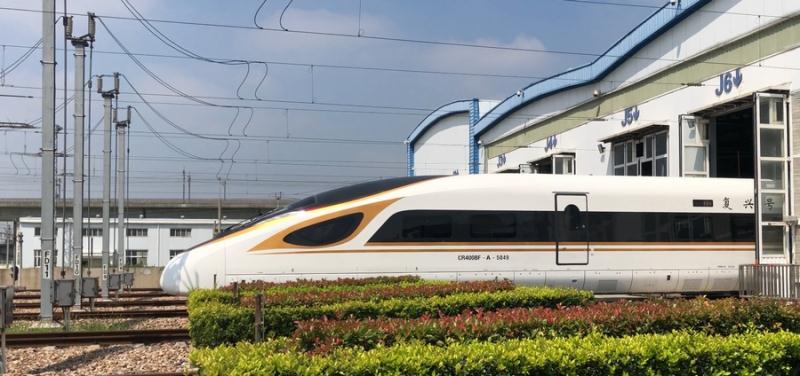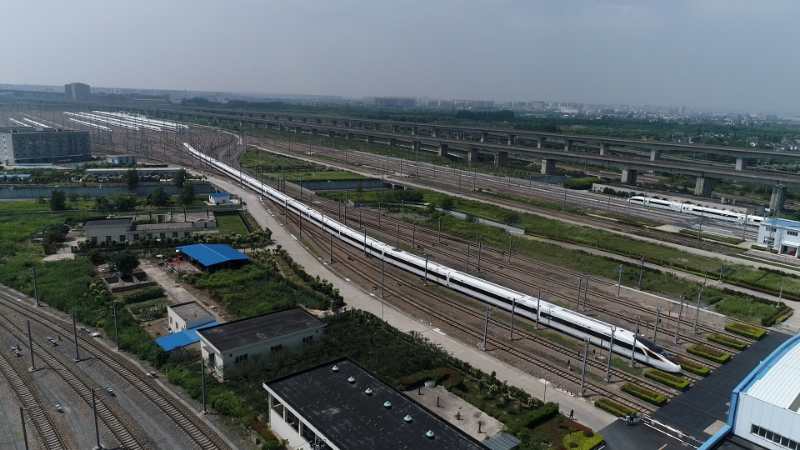You are using an out of date browser. It may not display this or other websites correctly.
You should upgrade or use an alternative browser.
You should upgrade or use an alternative browser.
News on China's scientific and technological development.
- Thread starter Quickie
- Start date
Jura The idiot
General
now noticed the tweet
China’s new and longer Fuxing bullet trains will start to run on the Beijing-Shanghai line on July 1. Measuring more than 400 meters in length, the new 350-kph train has 16 carriages, twice as many as current ones, and can carry nearly 1,200 passengers.


China’s new and longer Fuxing bullet trains will start to run on the Beijing-Shanghai line on July 1. Measuring more than 400 meters in length, the new 350-kph train has 16 carriages, twice as many as current ones, and can carry nearly 1,200 passengers.


antiterror13
Brigadier
The exascale prototype to be installed this June, operational at the end of 2018. Tianhe-3 is projected to reach exascale in 2020 as it was planned.
The Chinese version of the article claimed that the speed of the prototype is 200 times of Tianhe-1 which is 4.7 peta flops after its upgrade (also referred as Tianhe-1A). That is 940 peta flops, just slightly below 1 exa flops. With the full 2019 and some months in 2020, reaching 1 exa flops looks within reach.
what CPU and accelerator will be used for this monster ? I do hope no US parts or software on this machine otherwise Trump will find an excuse to ban them
don't worry, it's all domestic.what CPU and accelerator will be used for this monster ? I do hope no US parts or software on this machine otherwise Trump will find an excuse to ban them
CPU: FT-2000 by NUDT
Accelerator is GPDSP: Matrix2000 (already in Tianhe 2A) by NUDT.
OS: Linux (kylin)
On another note, actually, I think to be fare, we should be fair to ZTE, NUDT used intel and nvdia on Tianhe 2 and was hit by Obama. Why should ZTE be more blamed for using American components? It is a sad reality the we have to live by, it's a duty of all Chinese to make a change. The focus should be "just do it" than blaming somebody. I am glad that NUDT and the likes is doing it. I hope ZTE will rise again soon with the support from the government, so Trump will be just another Obama, crushed by the wheels of history.
Jura The idiot
General
Yesterday at 9:26 PM
World's fastest train designed and assembled in Qingdao
2018-06-09 13:08 GMT+8
related:now noticed the tweet
China’s new and longer Fuxing bullet trains will start to run on the Beijing-Shanghai line on July 1. Measuring more than 400 meters in length, the new 350-kph train has 16 carriages, twice as many as current ones, and can carry nearly 1,200 passengers.


World's fastest train designed and assembled in Qingdao
2018-06-09 13:08 GMT+8
At the manufacturing base of CRRC Qingdao Sifang Co. Ltd, a major designer of high-speed trains, Zhang Fangtao is busy giving interviews from both domestic and international media, as the 2018 Shanghai Cooperation Organization Summit in Qingdao has attracted thousands of journalists worldwide.
In the driver’s cabin of a bullet train, Zhang Fangtao said that the train could run at a speed of up to 350 km/hr, which is the fastest in the world for commercial operations. “Now passengers traveling on the routes between Beijing and Shanghai, and between Beijing and Guangzhou can sit in the high-speed trains like this one, the Fuxing CR400AF. Some of them would put a coin on the windowsill to see whether the train can move steadily at such a high speed,” said Zhang.
Located in the town of Jihongtan in Qingdao's Chengyang district, the manufacturing plant of the high-speed trains covers an area the size of 248 football fields. Besides the plant, the town is seeing multiple research institutions and a series of industrial chain companies related to high-speed trains under construction. In China, Jihongtan is nicknamed “The Bullet Train Town.”
China owns full intellectual property rights over the trains by using homegrown technologies. The high-speed trains are also called as the high-speed electric multiple unit (EMU) trains.
CRRC Qingdao Sifang Co. Ltd started to carry out scientific research and develop the Fuxing EMU trains as early as 2012. Designing and manufacturing the high-speed train is an extremely complicated project, which involves countless top-level technologies.
The train contains more than 500,000 different machine components, and it took thousands of designs on different parts of the train. To design the head of the train, the research team at first came up with 46 different head models, 23 of which were selected. Then seven of them went through tests. The final winner looked like the front face of a dragon and was given the nickname “Flying Dragon.” Such a design successfully reduced wind resistance by 12 percent. According to the company, the paper used to print all the designs can pile up as high as one meter.
So far, high-speed trains in China have received more than 1,000 patents. Before being put into operation, the trains have to go through stringent tests at a speed between 200 km/hr and 400km/hr and also experience extreme weather conditions at 40 degrees Celsius and minus 40 degrees Celsius. In 2015, the Fuxing EMU models took an accumulative trail test of more than 610,000 kilometers, a distance equal to 15 trips around the equator.
Tan Zheng, the company's vice general manager of the overseas marketing department, said that the CR400AF model received its first overseas orders from Indonesia this year. Besides high-speed trains, the company also designs and manufactures diesel multiple-unit trains, metro trains, intercity EMUs and metro vehicles based on special tailored orders from other countries.
So far, 43 percent of the high-speed trains in the world are assembled in the coastal city of Qingdao. As of 2017, CRRC Sifang Co., Ltd. had signed export orders to send about 5,000 trains to 20 countries and regions.
Jura The idiot
General
Yesterday at 6:31 AM
U.S. says it overtakes China to have world's fastest supercomputer
Xinhua | 2018-06-09 07:39:09
while for now the news ischecked now, not to forget to check ... Monday, June 25th
Presentation
TOP500 & Green500 Awards
U.S. says it overtakes China to have world's fastest supercomputer
Xinhua | 2018-06-09 07:39:09
The U.S. Department of Energy's Oak Ridge National Laboratory (ORNL) said on Friday the country reclaimed the world's most powerful supercomputer.
The computer named "Summit" has a peak performance of 200,000 trillion calculations per second or 200 petaflops, breaking the record of China's top-ranking Sunway TaihuLight with processing capacity of about 125.4 petaflops, according to ORNL.
It is about a million times faster than a typical laptop. For certain scientific applications, it will also be capable of more than 3 billion billion mixed precision calculations per second, or 3.3 exaops.
"Summit" will provide unprecedented computing power for research in energy, advanced materials and artificial intelligence (AI), among other domains, enabling scientific discoveries that were previously impractical or impossible, according to ORNL.
Also, "Summit" offers opportunities for the integration of AI and scientific discovery, enabling researchers to apply techniques like machine learning and deep learning to problems in human health, high-energy physics, materials discovery and other areas.
"Today's launch of the Summit supercomputer demonstrates the strength of American leadership in scientific innovation and technology development. It's going to have a profound impact in energy research, scientific discovery, economic competitiveness and national security," said U.S. Secretary of Energy Rick Perry.
The computer uses an IBM AC922 system consisting of 4,608 compute servers, each containing two 22-core IBM Power9 processors and six NVIDIA Tesla V100 graphics processing unit accelerators.
Seems Summit will be the champion in June when the 200 petaflops is confirmed. Since China in June just had pre-exa (tianhe3) prototype installed, it takes time to debug and get real numbers available in time. It would be November when the prototype can get something meaningful, maybe it will get the championship back. In the meantime there is another pre-exa prototype (shenwei taihulight successor) supposed to be installed in June and up running by year end. It will be an exciting year.
antiterror13
Brigadier
Very interesting video, showing how close Xi and Putin are ... also show Xi knows the stuff well ..... the train is going just over 300km/h and there is no vibration at all
Chinese President Xi and Russian President Putin takes the CRH to Tianjin (8 June 2018)
Chinese President Xi and Russian President Putin takes the CRH to Tianjin (8 June 2018)
solarz
Brigadier
Very interesting video, showing how close Xi and Putin are ... also show Xi knows the stuff well ..... the train is going just over 300km/h and there is no vibration at all
Chinese President Xi and Russian President Putin takes the CRH to Tianjin (8 June 2018)
Unfortunately, actual passenger trains don't have that kind of dining room! LOL
antiterror13
Brigadier
Unfortunately, actual passenger trains don't have that kind of dining room! LOL
you could as long as you are prepared to pay big $
